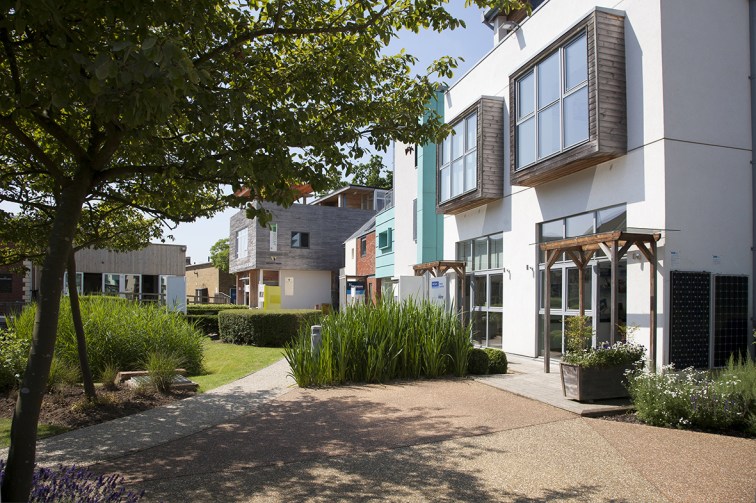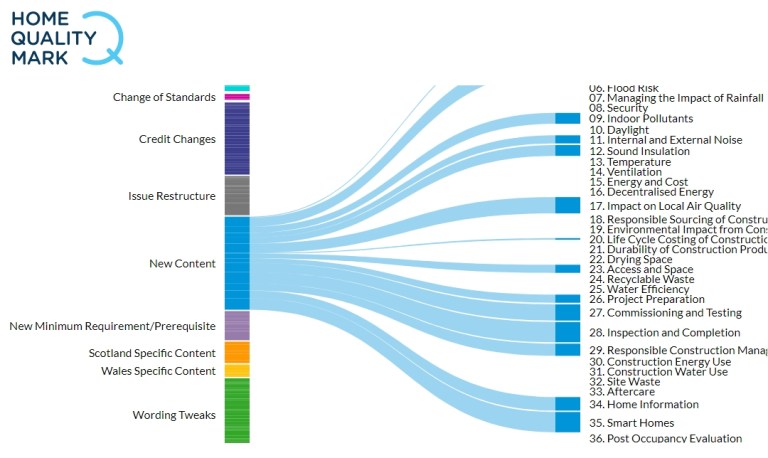Improving home quality with HQM ONE
[edit] Quality housing for our communities is as important as ever.
With Government’s pledge to build a million new homes by 2020, a major review of building regulations, a growing skills gap and increasing amounts of homeowners reporting defects[1], we clearly need more homes and these homes need to be fit for purpose; they need to be high-quality.
As an industry we need to give consumers, communities and investors confidence that homes will live up to expectations. They need to be affordable and healthy to live in, with a low environmental impact.
The Building Research Establishment (BRE) is the largest UK charity specifically dedicated to research and education in the built environment, and we have learned from decades of experience to help build a better world; from our boundary-pushing innovation parks, to BREEAM, the world’s leading sustainability assessment method for developments.
Fig1: BRE’s innovation park, Watford, UK.
Using this knowledge we have developed the Home Quality Mark (HQM), to help consumers make informed decisions that they can trust, when looking to buy or rent a new home. And the standard is going through an update; HQM ONE.
A key part of HQM ONE’s proposed changes is to recognise new standards that help deliver high-quality homes.
[edit] How does HQM recognise the delivery of quality?
To start with, all homes need to have a compliant building warranty in place; one that’s recognised by the Trading Standards Institute or an industry-backed body like the Consumer Code for Home Builders. This helps establish a starting level of assurance, because these warranties require:
- Warranty home inspections during construction
- Support if any serious defects emerge during the first 10 or so years of occupation, and
- Standards around customer service for the first couple years of occupation from the developer.
For HQM ONE, we want to go further than this by introducing new standards that all HQM homes need to meet, to enhance the value of an independently certified HQM home across key factors that are important, for any home to achieve.
If they can’t meet these standards, it raises the question; are they really good enough?
The proposed standards provide a consistent process throughout a home’s development from early design through to handover and in-use. They include:
- Agreeing a plan to outline how quality outcomes are going to be delivered throughout the project
- Producing a procurement policy to ensure goods and specifications are used that deliver high-quality performance standards, in-practice
- Clear communication links with trades and site operatives so quality processes are carried out during construction
- Keeping a transparent record throughout construction that shows the quality assurance measures that have been taken, which occupants will have access to, to help resolve problems if they emerge, with minimal disruption
- Carrying out good practice commissioning of building systems and services by professionals who are not checking their own work
- Ensuring each home is finished and habitable by highlighting and resolving any defects via a visual inspection, before occupants move in
- Giving occupants a handover visit to demonstrate how to manage the home in the most comfortable and efficient way, backed up by clear, user-friendly information.
These activities establish the starting point that all quality homes should begin with. Going beyond this, we are proposing for HQM ONE to award increasing amounts of credits the more that is done to deliver quality.
This includes recognising where:
- Pre-testing and quality assurance of building fabric, to help fix anything that prevents targeted airtightness levels from being met, early on before the primary air barrier is covered up
- Post-construction testing, including airtightness testing and thermographic surveys are carried out on the assessed home, to help ensure fabric performance levels are met in-practice
- Giving potential occupants the right for them, or their representative, to carry out independent, visual inspections, with defects dealt with before committing to buy the home
- Inspections from professionals with the appropriate experience, who are based on-site at key stages of construction, for every assessed home. Extra recognition is given where this person is independent, like a clerk of works type role
- Proactive visits during the early stages to help homes perform as well as they can
- Decent customer service and on-call support.
All these credits are optional to encourage flexible processes to achieve quality outcomes.
We have also made more credits available to the ‘Delivery’ section (Knowledge sharing, in Beta) and re-structured it, to put more emphasis on delivering quality homes (fig2 summarises the new content across HQM issues, including to issues on quality).
Fig2: Summary of proposed new content across technical issues in HQM ONE.
Throughout the consultation period we will be collecting feedback on our proposals to help shape the final version of the scheme and we would really like to know what you think, whether you are in industry or are a member of the public.
[1] The 2015 National New Home Customer Satisfaction Survey carried out by the Home Builders Federation (HBF) and warranty provider National House Building Council (NHBC), showed that 93% of buyers report problems to their builders – and of these, 35% report 11 or more problems.
[edit] Related articles on Designing Buildings Wiki
Featured articles and news
RTPI leader to become new CIOB Chief Executive Officer
Dr Victoria Hills MRTPI, FICE to take over after Caroline Gumble’s departure.
Social and affordable housing, a long term plan for delivery
The “Delivering a Decade of Renewal for Social and Affordable Housing” strategy sets out future path.
A change to adoptive architecture
Effects of global weather warming on architectural detailing, material choice and human interaction.
The proposed publicly owned and backed subsidiary of Homes England, to facilitate new homes.
How big is the problem and what can we do to mitigate the effects?
Overheating guidance and tools for building designers
A number of cool guides to help with the heat.
The UK's Modern Industrial Strategy: A 10 year plan
Previous consultation criticism, current key elements and general support with some persisting reservations.
Building Safety Regulator reforms
New roles, new staff and a new fast track service pave the way for a single construction regulator.
Architectural Technologist CPDs and Communications
CIAT CPD… and how you can do it!
Cooling centres and cool spaces
Managing extreme heat in cities by directing the public to places for heat stress relief and water sources.
Winter gardens: A brief history and warm variations
Extending the season with glass in different forms and terms.
Restoring Great Yarmouth's Winter Gardens
Transforming one of the least sustainable constructions imaginable.
Construction Skills Mission Board launch sector drive
Newly formed government and industry collaboration set strategy for recruiting an additional 100,000 construction workers a year.
New Architects Code comes into effect in September 2025
ARB Architects Code of Conduct and Practice available with ongoing consultation regarding guidance.
Welsh Skills Body (Medr) launches ambitious plan
The new skills body brings together funding and regulation of tertiary education and research for the devolved nation.
Paul Gandy FCIOB announced as next CIOB President
Former Tilbury Douglas CEO takes helm.
UK Infrastructure: A 10 Year Strategy. In brief with reactions
With the National Infrastructure and Service Transformation Authority (NISTA).
























